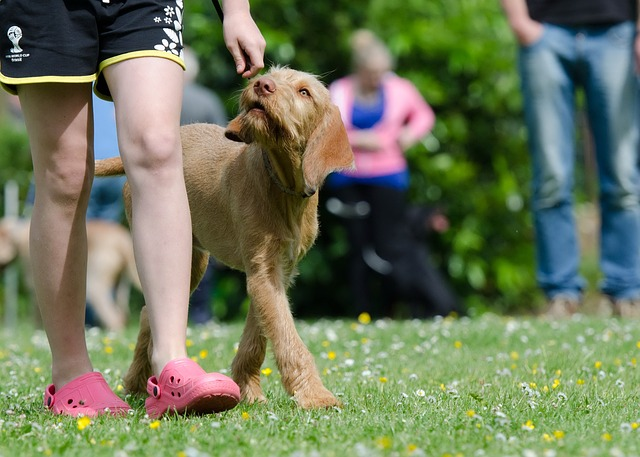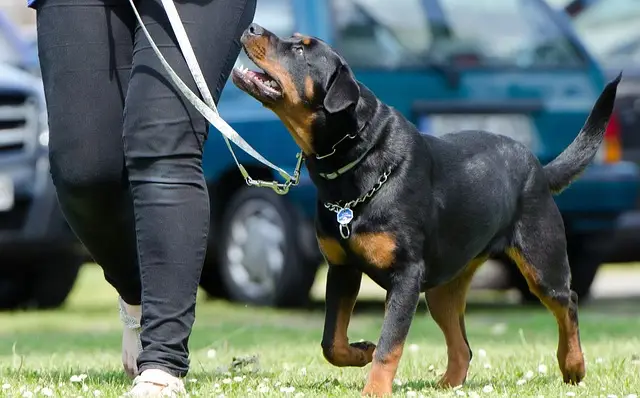How To Teach A Dog To Heel? Have you ever been on a walk with your dog, only to have them constantly pull on the leash and drag you around? Or do they always seem too distracted to listen when you tell them to stay by your side? Learning how to heel is an essential command for any dog as it allows them to walk calmly beside their owner without pulling or getting distracted.
Teaching your dog to heel not only makes walks more enjoyable, but it also ensures their safety by keeping them close and under control. It requires patience and consistency, but with the right training techniques, any dog can learn this important skill. In this guide, we will discuss everything you need to know about teaching your dog to heel in easy-to-follow steps.
What is Heeling?
Heeling is a basic obedience command that teaches your dog to walk calmly and closely beside you. It requires them to stay on one side of your body, usually the left, and follow at the same pace as you without pulling or getting distracted by their surroundings.
This command is essential for all dogs, especially those who tend to pull on their leash or become easily distracted during walks. It not only makes walks more enjoyable for both you and your dog but also ensures their safety by keeping them close and under control.
Heeling is also an important foundation for other advanced commands such as off-leash walking and competition-level obedience. By teaching your dog to heel, you are establishing yourself as the leader and gaining their respect and trust.
Steps to Teach Your Dog To Heel

Teaching your dog to heel requires patience, consistency, and positive reinforcement. Here are the steps you can follow to effectively train your dog to heel:
Start indoors
When beginning to teach your dog to heel, it’s best to start indoors where there are minimal distractions. Choose a quiet area, such as a living room or hallway, where your dog can focus solely on you. Begin by putting a leash on your dog, even though you’re inside; this will help them associate the leash with the heeling command.
Stand still with your dog’s favourite treats in hand and encourage them to come to your chosen side—usually the left. Hold the treats close to your side to guide them into the correct position. Let your dog sniff the treats to get them interested and focused on you.
Once they are in the correct position, reward them with a treat and praise. Repeat this several times until they consistently come to your side without needing much guidance. This step is crucial for building the foundation for healing and ensuring your dog understands the initial position they need to maintain.
Choose the side
When teaching your dog to heel, it’s essential to choose a side for them to walk on. Most people prefer their dog to walk on the left side, but you can choose whichever side you find most comfortable. Make sure to stick with this chosen side throughout the training process and avoid switching sides.
Choosing a consistent side will help your dog understand where they need to be when heeling, minimising confusion and making the learning process smoother. Plus, it’s also important when walking in public or around other dogs to have your dog constantly on the same side for safety and control purposes.
Use a leash and treats
Using a leash is crucial for teaching your dog to heel. The leash should be short enough, so your dog stays close by but long enough that they can maintain their natural gait without feeling restricted. Keep a treat pouch handy with small, bite-sized treats that your dog loves.
As you start walking, hold the leash firmly but not too tight. If your dog starts pulling or straying off to the side, use gentle tugs on the leash to guide them back into position. This will reinforce where they need to be and help them understand that they need to stay close.
As you walk, keep your dog motivated by occasionally giving them a treat and praising them when they maintain their position. This positive reinforcement will encourage them to continue healing correctly.
Start walking
Once your dog is comfortable with the initial position, it’s time to start walking. Begin by taking small steps and gradually increase the distance as your dog gets better at maintaining their position beside you. Make sure to maintain a consistent pace and pay attention to your dog’s movements.
If your dog starts pulling or getting distracted, use gentle tugs on the leash and verbal cues like “heel” or hand signals such as holding out your left arm as a reminder of where they should be positioned. This will help them remember what is expected of them and reinforce the correct behaviour.
Use verbal cues and hand signals
Consistency is key when teaching your dog to heel, and using verbal cues and hand signals can help with this. Choose a specific word or phrase, such as “heel” or “close,” to use every time you want your dog to get into position. Say this cue before rewarding them with a treat so they learn to associate it with the desired behaviour.
Similarly, use consistent hand signals each time you want your dog to heel. For example, holding out your left arm parallel to the ground can serve as a visual cue for your dog to stay on that side.
Practise these cues and signals regularly during training sessions to help your dog understand and respond to them consistently. This will make it easier for you to communicate with your dog when walking in public or during other situations where healing is necessary.
Practice consistently
As with any obedience command, consistency is crucial when teaching your dog to heel. It’s essential to practise regularly and make healing a part of your daily routine. This will help your dog remember what is expected of them and reinforce the behaviour until it becomes second nature.
Practice in different environments, such as indoors and outdoors, and gradually increase the distractions as your dog gets better at heeling. Be patient and consistent, and remember that every dog learns at their own pace.
Reward and praise your dog
Positive reinforcement is the most effective way to train your dog, and it’s no different when teaching them to heel. Make sure to reward your dog with treats and praise each time they maintain their position correctly. This will encourage them to continue heeling and reinforce the desired behaviour.
It’s also essential to remain patient and avoid punishing or scolding your dog if they make a mistake. Stay calm, use gentle corrections when needed, and focus on rewarding the correct behaviour.
So these are the steps to teach your dog to heel. Remember to be patient, consistent, and use positive reinforcement throughout the training process. With practice and patience, your dog will learn to heel beside you like a pro.
Does your dog already know how to heel?
If your dog is already familiar with the basics of heeling, such as choosing a side and maintaining their position when walking, you can work on adding more advanced skills to their heeling repertoire. These skills include turning smoothly, stopping on command, and changing pace while heeling.
To teach these advanced skills, start by practising them separately from regular walks. Use verbal cues and hand signals to communicate what you want your dog to do and reward them for successfully following the commands. Gradually increase the difficulty by incorporating these skills into your walks.
It’s also essential to remain patient and consistent during this process. Your dog may take some time to learn these new commands, so make sure to praise and reward them for any progress they make.
Additionally, it’s important to continue practising the basics of heeling regularly to maintain consistency and reinforce the correct behaviour. Remember that dogs thrive on routine and repetition, so incorporating training into your daily walks can be a fun and positive experience for both you and your furry friend.
Does your dog struggle with heeling?
If your dog is having difficulty learning to heel, it’s crucial to identify the root cause of the problem. Some dogs may have a higher prey drive and get easily distracted by squirrels or other animals, while others may simply be too energetic and excited during walks.
In these situations, it’s essential to address the underlying issue before attempting to teach healing. For example, if your dog gets easily distracted, you may need to work on their focus and attention during training sessions first.
On the other hand, if your dog is too energetic during walks, consider incorporating more physical exercise into their routine to help them release some of that energy before attempting obedience training.
It’s also important to remember that every dog is different, and they may require a different approach or more time to learn heeling. If you’re struggling, don’t be afraid to seek help from a professional dog trainer who can offer personalised guidance and support.
Contact Blakehurst Vet For Your Pet’s Health Care
When it comes to your pet’s health, you want nothing but the best. That’s why at Blakehurst Vet, we strive to provide exceptional care for your furry family members.
Our spacious and modern facility is equipped with experienced doctors and nurses who are dedicated to keeping your pets safe and happy. We understand that visiting the vet can be stressful for both pets and their owners, which is why we have a large reception area that is clean, calming, and separates cats and dogs.
We offer a wide range of services including dental care, surgery, chemotherapy, palliative care, and more. Our team works hard to keep up-to-date with the latest practices in veterinary medicine so that we can provide personalised care for each individual pet.
At Blakehurst Vet, we also prioritise convenience for our clients. We offer same-day appointments and urgent matters are always given priority. You can book your pet’s appointment online or by calling our friendly team at 9547 2750.
FAQs
How can I start teaching my dog to heel?
Teaching a dog to heel involves getting the dog to walk at your side with a loose leash. Start by using dog treats to get your dog’s attention. When the dog is in the heel position, give the heel command and reward with a treat. Repeat this process during dog walks to reinforce the behavior.
What are some tips for maintaining leash manners?
To maintain leash manners, ensure you practice loose leash walking regularly. When your dog pulls, stop walking and only move forward when the leash is loose. This will teach your own dog that pulling doesn’t get them where they want to go. Dog owners should be consistent and patient in their dog training.
How can I prevent my dog from getting distracted during walks?
Preventing distractions involves keeping your dog’s nose focused on you. Use dog treats to keep their attention, and practice the heel command frequently. Most dogs will learn to ignore distractions if they are consistently rewarded for good behavior during their training.
Why is the heel position important in dog training?
The heel position is crucial in dog training because it establishes control and ensures safety during dog walks. It is especially important for hunting dogs and dog sports where precise movement is needed. Training dogs to heel helps dog owners maintain control and improves the overall walking experience.
Can teaching a dog to heel help with food allergies?
While teaching a dog to heel doesn’t directly address food allergies, having a well-trained dog can make it easier to manage situations where food is present. Dog owners can control their dog’s movements and prevent them from getting into potentially allergenic foods. This is particularly helpful during dog walks in areas where food might be on the ground.
Conclusion
Teaching your dog to heel is a valuable and practical skill that can make dogs walk more enjoyable for both you and your pet. With patience, consistency, and positive reinforcement, any dog can learn to heel like a pro.
Remember to always prioritise your dog’s individual needs and seek professional help if needed. And don’t forget to schedule regular check-ups with a trusted veterinarian, like those at Blakehurst Vet, to ensure your pet’s overall health and happiness. Happy training!

